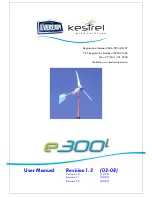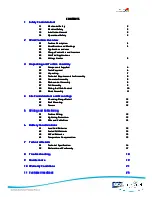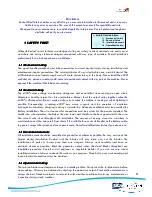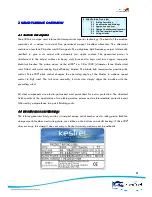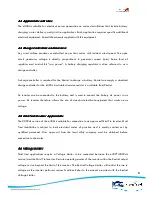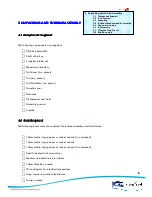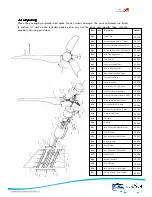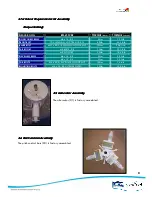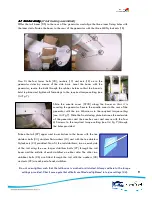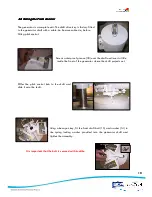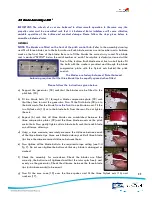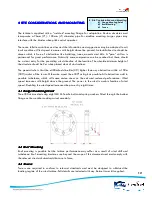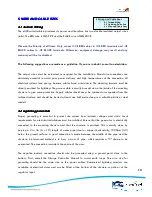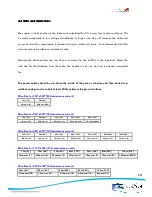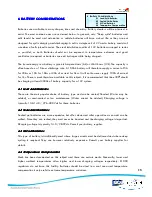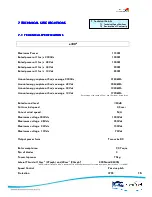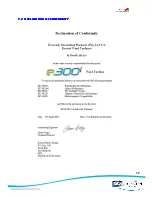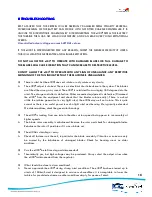
e300i User Manual
Document #: 0503M01A
REV : 1.3
Approval:
Date: March ’08
Page 3 of 25
1
1
S
S
a
a
f
f
e
e
t
t
y
y
C
C
o
o
n
n
s
s
i
i
d
d
e
e
r
r
a
a
t
t
i
i
o
o
n
n
s
s
1
1
.
.
1
1
M
M
e
e
c
c
h
h
a
a
n
n
i
i
c
c
a
a
l
l
S
S
a
a
f
f
e
e
t
t
y
y
1
1
.
.
2
2
E
E
l
l
e
e
c
c
t
t
r
r
i
i
c
c
a
a
l
l
S
S
a
a
f
f
e
e
t
t
y
y
1
1
.
.
3
3
I
I
n
n
s
s
t
t
a
a
l
l
l
l
a
a
t
t
i
i
o
o
n
n
H
H
a
a
z
z
a
a
r
r
d
d
s
s
1
1
.
.
4
4
O
O
p
p
e
e
r
r
a
a
t
t
i
i
o
o
n
n
a
a
l
l
S
S
a
a
f
f
e
e
t
t
y
y
Disclaimer
Kestrel Wind Turbines makes every effort to give accurate information in this manual and is in no way
liable for any error or omission. The user of this manual assumes full responsibility and risk.
We appeal to your common sense to read and apply the safety notes. Consult professional engineers
and take advice if you are unsure.
1 SAFETY FIRST
1 SAFETY FIRST
1 SAFETY FIRST
1 SAFETY FIRST
Although Kestrel’s wind turbines are designed with your safety in mind, accidents can easily occur
and there are always inherent dangers associated with any type of machine.
Consult installation
professionals if you lack experience or confidence.
1.1 Mechanical Safety
1.1 Mechanical Safety
1.1 Mechanical Safety
1.1 Mechanical Safety
Use good handling methods and take precautions to avoid physical injury during installation and
maintenance/repair procedures. The rotating blades of any wind turbine are a main hazard. The
e300
iiii
blades are extremely tough and will cause serious injury to the body.
Never install the e300
iiii
such that any person or animal could come into accidental contact with any part of the machine. Never
approach the machine if the blades are rotating.
1.2 Electrical Safety
1.2 Electrical Safety
1.2 Electrical Safety
1.2 Electrical Safety
The e300
iiii
output voltage can become dangerous and even lethal when running on open circuit.
Maintain a healthy respect for this wind turbine.
Always short the output wires together when the
e300
iiii
is disconnected. Do not work on the system when the turbine is running or when lightning is
possible.
Disconnecting a running e300
iiii
may cause a spark and the presence of explosive
hydrogen from battery charging is always a possibility.
Adequate ventilation must be provided for
battery installations.
The wire size used for connections must be correct for the powers supplied. The
smaller the wire diameter, the higher the wire losses and therefore the heat generated in the wire.
Use correct wire sizes throughout the installation.
The amount of energy stored in a battery is
considerable and fire can result from shorts.
Fit a suitable fuse or circuit breaker in the battery cable.
In general, respect the system and use common sense. Consult a qualified electrician if you are unsure.
1.3 Installation Hazards
1.3 Installation Hazards
1.3 Installation Hazards
1.3 Installation Hazards
All installation work should be completed at ground level wherever possible.
Be very aware of the
blades during installation. Contact with the blades will only injure you, not the blades. The
installations of poles or towers pose their own dangers. Always work carefully and have an
assistant wherever possible.
Short the generator output wires (Red and Black) throughout any
installation procedure.
Consult a civil engineer or reputable builder if you are not sure about
installing structures. Always re-check the work as you progress. Slack bolts, poor workmanship and
loose electrical connections must be avoided.
1.4 Operational Safety
1.4 Operational Safety
1.4 Operational Safety
1.4 Operational Safety
The turbine blades are dangerous.
Respect a rotating turbine.
Always shut the turbine down before
approaching. This may be achieved by shorting the generator output.
Preventative maintenance is
always the best.
Checks are best carried out in calm weather conditions. Avoid any maintenance or
inspection during windy weather.
3

